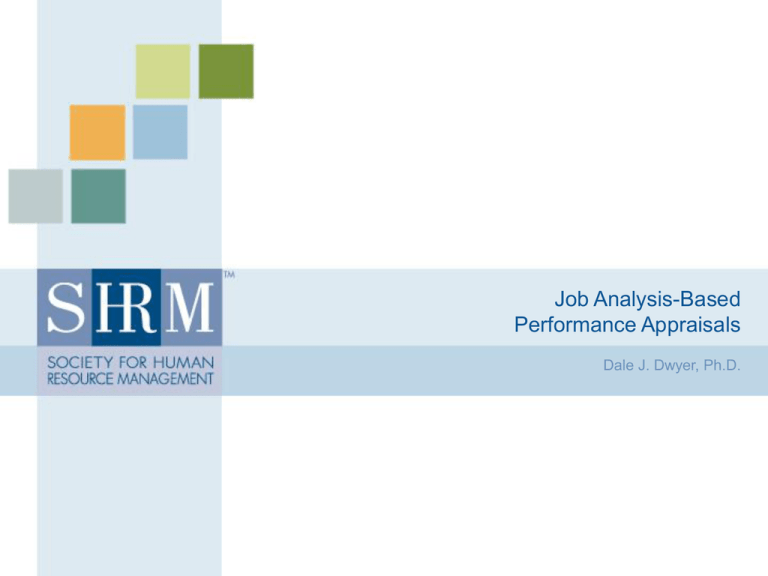Job Analysis-based Performance Appraisal
advertisement

Job Analysis-Based Performance Appraisals Dale J. Dwyer, Ph.D. What factors affect work performance? How do you measure those factors? How does Job Analysis help measure job performance? In This Session…. • You will learn how to measure performance behavior, skills and competencies, and outcomes. • You will understand the design issues of performance appraisal instruments. Linking Performance Planning and Strategy Organization’s Strategic Plan GOALS and STRATEGIES Individual Unit’s Strategic Plan GOALS and STRATEGIES Job and Task Requirements Performance Assessment Performance Behaviors and Results JOB ANALYSIS JOB DESCRIPTIONS Skills and Competencies Required Examples of Competencies 1. Leading and deciding. Takes control and exercises leadership. Initiates action, gives direction and takes responsibility. 2. Supporting and cooperating. Supports others and shows respect and positive regard for them in social situations. Puts people first, working effectively with individuals and teams, clients and staff. Behaves consistently with clear personal values that complement those of the organization. 3. Interacting and presenting. Communicates and networks effectively. Successfully persuades and influences others. Relates to others in a confident and relaxed manner. 4. Analyzing and interpreting. Shows evidence of clear analytical thinking. Gets to the heart of complex problems and issues. Applies own expertise effectively. Quickly learns new technology. Communicates well in writing. Examples of Competencies, cont’d. 5. 6. 7. 8. Creating and conceptualizing. Open to new ideas and experiences. Seeks out learning opportunities. Handles situations and problems with innovation and creativity. Thinks broadly and strategically. Supports and drives organizational change. Organizing and executing. Plans ahead and works in a systematic and organized way. Follows directions and procedures. Focuses on customer satisfaction and delivers a quality service or product to the agreed standards. Adapting and coping. Adapts and responds well to change. Manages pressure effectively and copes with setbacks. Performing and evaluating. Focuses on results and achieving personal work objectives. Works best when work is closely related to results and the effect of personal efforts is obvious. Shows an understanding of business, commerce and finance. Seeks opportunities for self-development and career advancement. Performance Standards Key factors to check when establishing criteria • Is it fair? • Is it attainable? • Is it clear? • Is it challenging? • Is it relevant? • Is it flexible? Designing the Appraisal Components to Determine • What to appraise > Behaviors (what an employee does) > Results (the outcomes of behaviors) • Type of appraisal > Evaluative (negative, positive) > Summative (overall judgment) > Formative (tells what needs improvement) • Scoring of appraisal > Weighting of dimensions or equivalency of dimensions > Separate overall score or weighted total score Types of Job Behaviors • Content (Task) Behaviors: Those that entail some transformation of raw materials into goods and services produced by the organization. • Contextual (Organizational Citizenship) Behaviors: Those that provide a good work environment and encourage highly proficient task behaviors. Behavioral Measures Critical Incidents Method > Manager prepares a record of the employee's highly favorable and unfavorable actions since the last rating time. > DOWNSIDE: Critical incidents may be perceived differently by managers and employees. Behaviorally Anchored Rating Scale > Identify the types of behavior actually found on the job. > These behaviors are checked by the rater to arrive at an evaluation of the employee. > DOWNSIDE: Although time-consuming and costly to develop, they do give the rater benchmarks in the form of specific behaviors. When to Measure Results 1. 2. 3. 4. Do employees possess needed skills and knowledge (can they do the job)? How closely are behaviors related to results? Can you see consistent improvement in results as a consequence of performing the “right” behaviors? Are there different ways to do the job? Results-Based Measures Work Planning, Goal Setting, and Review: > General approach that is tailored to specific employee and job. > Can be done by manager with or without employee’s input. > DOWNSIDE: May not get goal commitment by employee. Management by Objectives (MBO): > Goals set from the top of the organization. > Goals achieved from the bottom of the organization become input to next level up. > Established jointly with manager and employee. > DOWNSIDE: Lots of paperwork and interdependence with other units and employees. Let’s Practice! For the next class, you will work with a few other students to design a performance appraisal tool. The goal of this exercise is to: • Determine the type of appraisal (evaluative, summative or formative). • Determine dimensions of the job to be appraised (behaviors and/or results). • Design the scoring and format of an appraisal.






